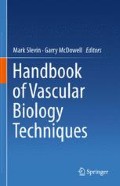Abstract
Unilamellar liposomes are well established carriers of chemotherapeutics. Most of the clinically approved liposome formulations for cancer treatment tend to rely on passive targeting of the tumour site, enabled by the leaky vasculature supplying the tumour tissue. This chapter deals with a method of preparing liposomes having two different fluorophores encapsulated in separate compartments; the lipid bilayer buries the non-exchangeable fluorophore while the aqueous interior (lumen) encapsulates the releasable payload. Such preparations can be used to quantitatively assess the ability of a particular formulation to release payload by deciphering the effects of accumulation and plasma clearance from actual content release within the microvasculature in live tissues and in real-time. The emphasis here is on liposome preparation by the technique of extrusion through polycarbonate membranes.
Access this chapter
Tax calculation will be finalised at checkout
Purchases are for personal use only
References
Maeda H, Wu J, Sawa T, Matsumura Y, Hori K (2000) Tumor vascular permeability and the EPR effect in macromolecular therapeutics: a review. J Control Release 65:271–284
Ruiz-Esparza GU, Flores-Arredondo JH, Segura-Ibarra V, Torre-Amione G, Ferrari M, Blanco E, Serda RE (2013) The physiology of cardiovascular disease and innovative liposomal platforms for therapy. Int J Nanomedicine 8:629–640
Dvir T, Bauer M, Schroeder A, Tsui JH, Anderson DG, Langer R, Liao R, Kohane DS (2011) Nanoparticles for targeting the infarcted heart. Nano Lett 11:4411–4414
Hermanson GT (2013) Bioconjugate techniques, 3rd ed Chapter 21. Liposome conjugates and derivatives. Academic Press, pp 921–949
Torchilin VP, Weissig V (2003) Liposomes: practical approach, 2nd edn. Oxford University Press, Oxford
Edwards KA, Baeumner AJ (2006) Analysis of liposomes. Talanta 68:1432–1441
New RRC (1990) Liposomes: a practical approach. IRL Press, Oxford
Stewart JC (1980) Colorimetric determination of phospholipids with ammonium ferrothiocyanate. Anal Biochem 104:10–14
Xu X, Khanb MA, Burgessa DJ (2012) Predicting hydrophilic drug encapsulation inside unilamellar liposomes. Int J Pharm 423:410–418
Sjoerd H, Reitan NK, Haraldseth O, de Lange Davies C (2010) Intravital microscopy in window chambers: a unique tool to study tumor angiogenesis and delivery of nanoparticles. Angiogenesis 13:113–130
Wu NZ, Braun RD, Gaber MH, Lin GM, Ong ET, Shan S, Papahadjopoulos D, Dewhirst MW (1997) Simultaneous measurement of liposome extravasation and content release in tumors. Microcirculation 4:83–101
Laschke MW, Vollmar B, Menger MD (2011) The dorsal skinfold chamber: window into the dynamic interaction of biomaterials with their surrounding host tissue. Eur Cell Mater 22:147–164
Djanashvili K, ten Hagen TLM, Blangé R, Schipper D, Peters JA, Koning GA (2011) Development of a liposomal delivery system for temperature-triggered release of a tumor targeting agent, Ln(III)-DOTA-phenylboronate. Bioorg Med Chem 19:112–1130
Pink DBS, Schulte W, Parseghian MH, Zijlstra A, Lewis JD (2012) Real-time visualization and quantitation of vascular permeability in vivo: implications for drug delivery. PLoS One 7:e33760. doi:10.1371/journal.pone.0033760
Gaber MH, Wu NZ, Hong K, Huang SK, Dewhirst MW, Papahadjopoulos D (1996) Thermosensitive liposomes: extravasation and release of contents in tumor microvascular networks. Int J Radiat Oncol Biol Phys 36:1177–1187
Offerman SC, Verma AK, Telfer BA, Berk DA, Clarke DJ, Aojula HS (2014) Ability of co-administered peptide liposome nanoparticles to exploit tumour acidity for drug delivery. RSC Adv 4:10779–10790
Oude BE, Mastrobattista E, Schiffelers RM (2013) Strategies for triggered drug release from tumor targeted liposomes. Expert Opin Drug Deliv 10:1399–1410
Author information
Authors and Affiliations
Corresponding author
Editor information
Editors and Affiliations
Rights and permissions
Copyright information
© 2015 Springer Science+Business Media Dordrecht
About this chapter
Cite this chapter
Aojula, H.S. (2015). Preparation of Liposomes with Dual Fluorophores to Follow Real-Time Content Release In Vivo. In: Slevin, M., McDowell, G. (eds) Handbook of Vascular Biology Techniques. Springer, Dordrecht. https://doi.org/10.1007/978-94-017-9716-0_26
Download citation
DOI: https://doi.org/10.1007/978-94-017-9716-0_26
Publisher Name: Springer, Dordrecht
Print ISBN: 978-94-017-9715-3
Online ISBN: 978-94-017-9716-0
eBook Packages: Biomedical and Life SciencesBiomedical and Life Sciences (R0)

